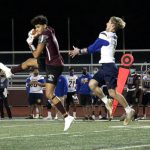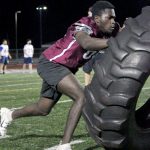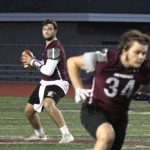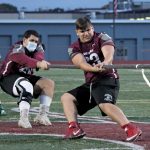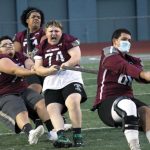By Kyle Brennan, Citizen’s News
NAUGATUCK — Naugatuck interim football coach Ollie Gray and his Greyhounds were, like every team in Connecticut, devastated when the CIAC canceled the traditional fall season Sept. 3.
But after the protests ended and reality set in, Gray, his assistant coaches and his players sat down to discuss the options in front of them for this fall.
The CIAC officially condoned two options: the continuation of conditioning workouts and an informal season featuring 7-on-7 scrimmages with lineman challenges. The possibility of forming a non-school-affiliated team to join the budding independent league was out there, too.
Eventually, Gray leaned on his upperclassmen to make a decision. Sitting around idly didn’t appeal to them, so they chose 7-on-7 over independent ball.
“Independent football is about $500 a player,” Gray said. “There were some of our players who could have done it, but a lot of them couldn’t. The captains didn’t want to do anything without the whole team. Especially those seniors, a lot of them have been together since their Pop Warner days, and they wanted to end this together.”
Naugatuck lined up four 7-on-7 scrimmages this fall, starting with a meeting against Seymour on Oct. 19. The competitions are split into two parts — a 7-on-7 game in which a team runs passing plays against a defensive secondary, and a series of strength and agility competitions between linemen. Those lineman drills include the one-man sled, tug of war and tire flips, among others.
The CIAC condoned those activities upon recommendations by the Connecticut Department of Public Health.
Gray said the first outing against the Wildcats was a rewarding experience.
“It was a lot of fun for the kids,” Gray said. “There was a lot of energy from the guys being pent up and wanting to get out on the field.”
About 50 players are engaged in workouts and competitions for Naugy, according to Gray. The unique nature of these activities allows freshmen, who traditionally practice separately from the varsity squad, to compete against and learn from upperclassmen.
“That’s one bright thing — freshmen and varsity usually don’t mix, but a lot of these upperclassmen are taking freshmen under their wings,” Gray said.
While wins and losses this fall won’t be remembered for long, Gray said the potential positive impacts on the football program could set the ‘Hounds up for success in the future.
“We just want to develop that team camaraderie,” Gray said. “It takes a lot to build a team and get a team on the same page. It’s team-building and working on our passing game. We’re working on routes and read progressions. The linemen are still working, too, with different blocking techniques. The kids are all into it.”
The existence of this modified fall season, though, doesn’t diminish the Greyhounds’ hopes — indeed, the hopes of all teams around the state — that a shortened spring season could happen.
The CIAC announced Sept. 29 that, pending public health guidance, traditional football could have a season with practices starting Feb. 22 and the final games April 17. The window, which was designed to reduce negative impacts on the spring season, would only leave time for five or six games.
The odds seem to be stacked against that possibility with no reliable predictions about when the COVID-19 pandemic might end, but Gray remains optimistic.
“I hope the CIAC comes through with the spring season,” Gray said.

